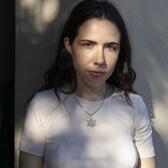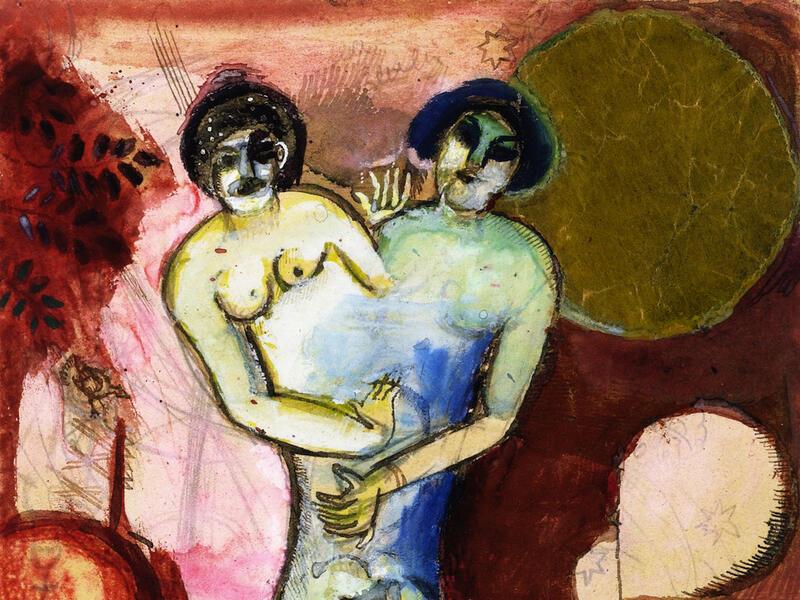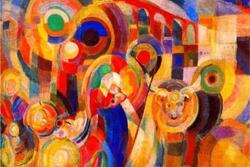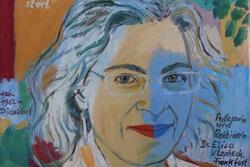This Chagall Piece Reflects My Nonbinary Gender
I so often feel split in my own body. I am no stranger to being in between. I’m nonbinary, queer, Jewish. I sometimes struggle to express the pressure I feel to be something solid when all I want to be is more like water.
There is a painting that speaks to this desire in me more than any other. It’s a Chagall painting called Hommage à Apollinaire, or Adam et Ève (study), and was inspired by his admiration for the poet and Surrealist Guillaume Apollinaire. The story of Adam and Eve is one that Chagall returned to often, over decades, in his work. It sometimes feels like he painted every moment of their lives. But I love this painting most.
It’s not a large oil painting, but a small gouache, watercolor, ink wash, pen and ink and collage on paper. In it, two torsos split from a single pair of legs. It’s impossible to know which side is Adam and which side is Eve—the left looks like it might have breasts, but also a mustache. Both faces are androgynous. If I wasn’t familiar with Genesis, I would wonder if these were bodies coming apart or falling into one. The left hand either pushes away from the torso or grasps onto it.
To me, the painting feels serene and tumultuous at the same time. The blood red background, the blue swirling inside the body, the pink beyond; the painting is full and rich and complicated. It contradicts itself at the same time that it completes itself.
The same is true of the figures. They are separate and yet not completely apart. They are one person and they are two people. It is a painting of Adam and Eve and it is also a painting of AdamEve, a figure who is both and yet neither.
There are many interpretations of exactly when during creation Eve was formed. Genesis 5:2 reads,“Male and female He created them,” which suggests that Adam and Eve were created as one androgynous form. Scholar Tamar Kadari writes, “[T]he creation of Eve is not presented as an act of detracting from and harming another complete creature, but as an act of separation, just as the creation of the upper and lower waters and of light and darkness were acts of detachment between two elements that had previously existed in an admixture.”
Though Chagall would paint other studies of the same AdamEve, and complete a large painting of the figure about a year later, his final rendition does not move me. It’s more exact, more fragmented, like broken glass. Less like mud, less like a birth. I am drawn to the mess and the mix of the body in his original rendition. It feels true to me.
I don’t see my masculinity and femininity as opposing or even separate. Yet, existing in a world that reads my body one way sometimes makes me feel there is another body, or indeed many bodies, hidden inside mine.*
I’m ambivalent about my presentation, the role my body does and might take in expressing my gender to the world. Would I like a thick mustache? Yes. And then, sometimes, no. Would I like to keep my breasts? Yes. And then, sometimes, I would like to have a flat chest. It’s not so much a destination I long for, but a physical fluidity I can show the world. From as early as I can remember, I’ve longed to be able to mold my body like clay that remains forever malleable.
I think I’m drawn to Chagall’s painting because I see myself reflected in it. I see myself in the not knowing whether it is with pleasure or pain that the figures split. I see myself in the unbraiding of two bodies that, in turn, creates a third, just as true and alive. I see myself in the mess of masculine and feminine. Though I doubt Chagall painted this piece with queer and trans and nonbinary bodies in mind, it’s still a gift to feel reflected in art. And it is a gift to feel reflected in Torah and Jewish storytelling.
Maybe I love this little study most of all because it invites me to imagine. I feel so limited by how my body is read by the world. It is through imagination and art that I can be many forms at once. This painting invites me to render myself my own AdamEve, to see myself as split and whole in the same moment.
*Each trans and nonbinary person has a unique relationship to their body and appearance, and so what I say about myself neither defines or defies anyone else’s experience.








tender and honest. Sorry the dissonance hurts, I wish it didn't for you, it sound like a wonderful source of empathic strength. I love Chagall too, for his anomalies, like the flying fiddler goat. Namaste.
Well written.
For non Hindus information , in Hindu mythology there is a representation of Lord Shiva and Goddess Parvathy as a single united entity in sculpture and it is named " Ardhanaareeswarer" in Tamil language meaning half Male God and Half Female God. You can view the sculpture in wikipaedia .There is a separate temple dedicated to this God at Thiruchengodu town in NAMAKKAL DISTRICT , Tamilnadu , India.
Good Luck
Thanks - from India
I love this reflection on your experience of your identity and the way you see it reflected in this Chagall painting. As an art therapist and someone who studied art history, I feel it is a beautiful thing when we can allow art to speak to our own experience and not reduce it to the artist's intention or the content of a traditional subject like the Adam and Eve story.